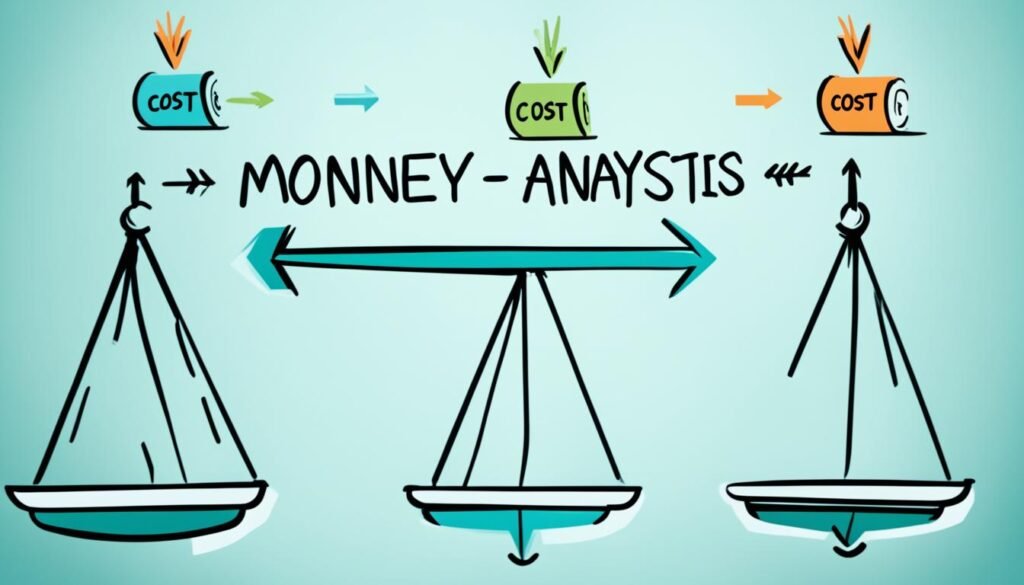Successful businesses often use a cost-benefit analysis (CBA) to make important decisions. This method looks at the good and bad sides of different business choices. It helps guide you to the best solutions.
A cost-benefit analysis is a useful tool that checks the pros and cons of different options. It compares the expected costs with the possible gains. This helps figure out if the benefits outweigh the costs and by how much.
By using this method, you get a clear view of the possible benefits and drawbacks. This helps you decide the best way to move forward.
Table of Contents
What Is a Cost-Benefit Analysis?
As a business owner, you make decisions every day that shape your company’s future. A cost-benefit analysis (CBA) helps you weigh the costs and benefits of a project. It’s about comparing the costs and benefits to see if a project is good for your business.
Cost-benefit analysis means adding up the costs of a project and then subtracting them from the expected benefits. If the benefits are more than the costs, it’s likely a smart choice.
Understanding Cost-Benefit Analysis
Cost-benefit analysis is a key tool for making decisions in business, used by both new and established companies. It’s a way to look at any decision, not just business ones. This method looks at both the money you can measure and the things you can’t, like how happy employees are or how customers feel.
It also considers the opportunity cost, or the benefits you give up by choosing one option over another. For projects, a positive net present value (NPV) means it’s a good investment. Direct costs are things like labor and materials, while indirect costs are things like rent and utilities. Intangible costs are harder to measure, like how a project affects customers or employees.
When doing a cost-benefit analysis, you might use sensitivity analysis or discount cash flows. It’s important to put a dollar value on each benefit. Sensitivity analysis shows how changes in estimates can affect the results.

This image from freepik
“Cost-benefit analysis is a cornerstone of UK transport appraisal, particularly through the New Approach to Appraisal (NATA), providing balanced cost-benefit results and detailed environmental impact assessments for transport investment projects.”
Steps of Conducting a Cost-Benefit Analysis
Doing a cost-benefit analysis is key for smart business choices. It involves five main steps to check if a project or investment is good. Let’s look at each step closely:
- Define the Project Scope: Start by setting clear goals, timelines, and tasks for the project. This sets up your analysis.
- Estimate Costs: Look at all the project costs, like direct, indirect, intangible, and opportunity costs. Getting costs right is key for a good analysis.
- Determine Benefits: Find out the project’s benefits, both direct and indirect. This could be more sales, happier customers, or a stronger market position.
- Compute the Analysis: Do the math to see how costs stack up against benefits. You might use tools like NPV, ROI, or IRR.
- Compare Alternatives: Look at the project alongside other options, comparing their costs and benefits. This helps you choose wisely.
By following these steps, you can do a cost-benefit analysis process that gives you deep insights. This analysis is a valuable tool for making smart choices. But remember, it’s just one part of the decision-making process.

“The cost-benefit analysis is a powerful tool that allows you to make informed decisions by quantifying the potential outcomes of your business initiatives.”
Whether it’s a new product, tech upgrade, or change in operations, the cost estimation and benefit evaluation process helps you make strategic choices. It’s a big help for your business.
Best Practices for Cost-Benefit Analysis
Doing a thorough cost-benefit analysis is key to smart business choices. To make sure your analysis is right and works well, follow some best practices. Let’s look at the main ways to improve your cost-benefit analysis.
Define Clear Objectives
First, define the goals of your cost-benefit analysis. Know the business issue or decision you’re tackling. Make sure your analysis matches these goals. This ensures you get the right data and focus on what’s most important.
Gather Accurate Data
Good data is the base of a solid cost-benefit analysis. Get your data from trusted sources like reports, financial statements, and expert views. Check the data’s accuracy to make sure your analysis is strong.
Evaluate Potential Risks
Think about the risks, not just the benefits, in your analysis. Use methods like scenario and sensitivity analysis to see how risks affect costs and benefits. This helps you make choices that are smart and aware of risks.
Ensure Transparency
Being open is crucial in cost-benefit analysis. Share your methods, assumptions, and where you got your data. This makes your analysis more credible and helps others understand and check your results.
Be Prepared to Revise
The business world changes, and so should your analysis. Be ready to update your analysis if big changes happen in assumptions, data, or business conditions. This keeps your decisions up-to-date and informed.
By using these best practices, you can make your cost-benefit analysis more accurate, credible, and effective. This helps you make better, strategic business choices.

“Conducting a thorough cost-benefit analysis is essential for making well-informed business decisions that maximize value and minimize risk.”
Cost-Benefit Analysis
When making business decisions, a cost-benefit analysis is key. It looks at the good and bad sides of a project or choice. It uses methods like net present value (NPV), benefit-cost ratio (BCR), internal rate of return (IRR), and payback period.
The net present value (NPV) figures out the worth of future money now. This helps you see if a project will make money. The benefit-cost ratio (BCR) compares a project’s gains to its costs. The internal rate of return (IRR) shows what return you can expect over time. The payback period tells you how long it takes to get back your initial investment.
Sensitivity analyses are used to deal with uncertainty. They check how changing important factors affects the results. This helps you make better choices.
Using these cost-benefit analysis methods, you can make choices based on data. This way, you can get the most benefits and reduce risks in your business.

“A well-designed cost-benefit analysis can be a powerful tool for understanding the true economic impacts of a project or decision.”
Conclusion
A cost-benefit helps businesses make smart, data-based choices. It lets companies look closely at the costs and benefits of a project or decision. This way, they can see the good and bad sides and pick the best option.
This analysis takes some work upfront to figure out costs and benefits. But, the insights it gives are very valuable. They help shape your business’s future.
By following best practices and using different analytical methods, you can make the most of cost-benefit analysis. This helps you get a good return on your investment and grow your business strategically. The data you get from this process helps you make better decisions. It lets you use your resources wisely and grab the best opportunities.
Cost-benefit is a flexible tool used in many industries and situations. It’s useful for checking out healthcare projects or seeing if new products or technologies are worth it. By using this method, you can set your business up for long-term success. You’ll make sure your decisions are based on a deep understanding of costs and benefits.



